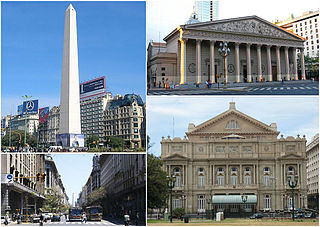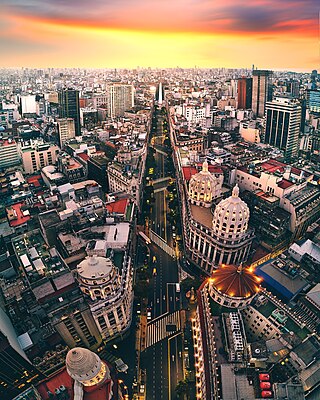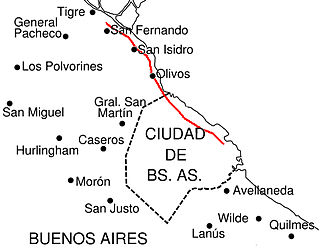
Belgrano is a northern and leafy barrio or neighborhood of Buenos Aires, Argentina.

Balvanera is a barrio or neighborhood of Buenos Aires, Argentina.

Recoleta is a barrio or neighborhood of Buenos Aires, Argentina, located in the northern part of the city, by the Río de la Plata. The area is perhaps best known to be the home of the distinguished Recoleta Cemetery. It is a traditional upper-class and conservative neighborhood with some of the priciest real estate in the city, known for Paris-style townhouses, lavish former palaces and posh boutiques.

San Nicolás is one of the neighbourhoods of Buenos Aires, Argentina, sharing most of the city and national government Neighborhood of Buenos Aires with neighboring Montserrat and home to much of the financial sector. It is referred usually as El Centro, and the part east of the 9 de Julio Avenue is known as Microcentro.

July 9 Avenue is a major thoroughfare in the city centre of Buenos Aires, Argentina. Its name honors Argentina's Independence Day, July 9, 1816.

Retiro is a barrio or neighborhood in Buenos Aires, Argentina. Located in the northeast end of the city, Retiro is bordered on the south by the Puerto Madero and San Nicolás, and on the west by the Recoleta.

Avenida Corrientes is one of the principal thoroughfares of the Argentine capital of Buenos Aires. The street is intimately tied to the tango and the porteño sense of identity. Like the parallel avenues Santa Fe, Córdoba, and San Juan, it takes its name from one of the Provinces of Argentina.

According to the World Travel & Tourism Council (WTTC) the travel and tourism sector of Argentina was moving towards recovering its pre-covid pandemic contribution to GDP in mid-2023, led by Buenos Aires.

Galerías Pacífico is a shopping centre in Buenos Aires, Argentina, located at the intersection of Florida Street and Córdoba Avenue.

Avenida Roque Sáenz Peña, better known as Diagonal Norte, is an important avenue in the San Nicolás neighborhood of Buenos Aires, Argentina. It is oriented south-east/north-west, diagonally bisecting the city blocks (manzanas) which give the city centre a checkerboard plan. It is named after President Roque Sáenz Peña, who held power from 1910 to 1914 and passed the law which established universal suffrage, secret ballot and an electoral register.

Avenida Rivadavia is one of the principal thoroughfares in Buenos Aires, Argentina, extending 23 miles (37 km) from downtown Buenos Aires to the western suburb of Merlo. It is considered the third longest avenue in the world after Yonge Street (Toronto) and Western Avenue (Chicago).
There are many landmarks in Buenos Aires, Argentina some of which are of considerable historical or artistic interest.

Avenida del Libertador is one of the principal thoroughfares in Buenos Aires, Argentina, and in points north, extending 25 km (16 mi) from the Retiro District of Buenos Aires to the northern suburb of San Fernando.

Avenida Santa Fe is one of the principal thoroughfares in Buenos Aires, Argentina. The artery is essential to the imaginary axis of Barrio Norte in Buenos Aires, comprising the areas influenced by the route of the avenue through Retiro, Recoleta and Palermo neighborhoods, it is considered one of the main shopping and strolling areas of the city, its many boutiques range from elegant to edgy, which has led it to be dubbed the 'Avenue of Fashion'. Upscale Alto Palermo, at Avenida Coronel Díaz, is one of the city's best-known vertical malls. Avenida Santa Fe is also an attraction for its architecture, strongly reminiscent of Paris. Its name pays homage to the eponymous province in Argentina.

Córdoba Avenue is one of the principal thoroughfares in Buenos Aires, Argentina.

Callao Avenue is one of the principal thoroughfares in Buenos Aires, Argentina.

The Buenos Aires Central Business District is the main commercial centre of Buenos Aires, Argentina, though not an official city ward. While the barrios of Puerto Madero and Retiro house important business complexes and modern high-rise architecture, the area traditionally known as Microcentro is located within San Nicolás and Monserrat, roughly coinciding with the area around the historic center of the Plaza de Mayo. The Microcentro has a wide concentration of offices, service companies and banks, and a large circulation of pedestrians on working days. Another name given to this unofficial barrio is La City, which refers more precisely to an even smaller sector within the Microcentro, where almost all the banking headquarters of the country are concentrated.

Harrods Buenos Aires was an Argentine retail company based in Buenos Aires, whose building was located on the corner of Córdoba Avenue and San Martin street. The store was a branch of the famous Harrods of London which was opened in 1849. Harrods Buenos Aires opened in 1914 and closed in 1998, since closure there has been numerous attempts to reopen the store.

Del Parque is a former train station in Buenos Aires, Argentina. It was the first railway station in the country, serving as terminus of Buenos Aires Western Railway. The station was located at the intersection of Cerrito and Tucumán streets.

Gath y Chaves Sociedad Anónima was an Argentine retail company headquartered in Buenos Aires and founded in 1883 by Lorenzo Chaves (1854–1928) and Alfred Gath (1852–1936). It was then acquired by English company Harrods, and was a favorite of the city's upper class. Among the large variety of products sold at Gath & Chaves stores were clothing, furniture, perfumes, phonograph records, shoes, tableware, and toys.






































